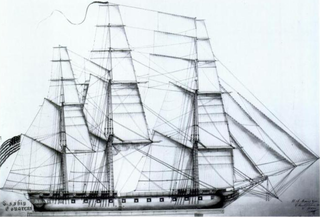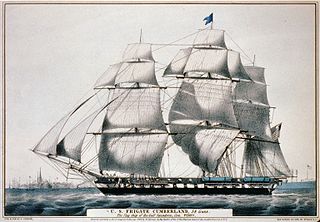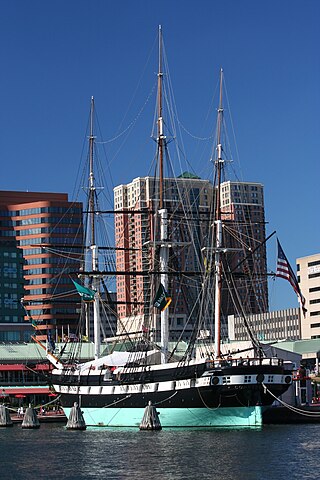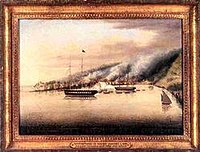
USS United States was a wooden-hulled, three-masted heavy frigate of the United States Navy and the first of the six original frigates authorized for construction by the Naval Act of 1794. The name "United States" was among ten names submitted to President George Washington by Secretary of War Timothy Pickering in March of 1795 for the frigates that were to be constructed. Joshua Humphreys designed the frigates to be the young Navy's capital ships, and so United States and her sisters were larger and more heavily armed and built than standard frigates of the period. She was built at Humphrey's shipyard in Philadelphia, Pennsylvania and launched on 10 May 1797 and immediately began duties with the newly formed United States Navy protecting American merchant shipping during the Quasi-War with France.
The third USS Dolphin was the brig in the United States Navy. Her plans were the basis of other brigs of that time. She was named for the aquatic mammal.

The first USS Raritan was a wooden-hulled, three-masted sailing frigate of the United States Navy built at the Philadelphia Navy Yard, laid down in 1820, but not launched until 13 June 1843, sponsored by Commodore Frederick Engle. She was one of the last sailing frigates of the United States Navy.

USS Columbus was a 92-gun ship of the line in the United States Navy. Although construction of the warship was authorized by Congress on 2 January 1813, plunder of the Washington Navy Yard by British troops in 1814 during the burning of Washington, combined with efforts to keep US military stores out of British hands, led to the destruction of any initial framing. Days after Congress re-authorized the vessel on 29 April 1816, a keel was laid and construction resumed.

The third USS Delaware of the United States Navy was a 74-gun ship of the line, named for the state of Delaware.

USS Pennsylvania was a three-decked ship of the line of the United States Navy, rated at 130 guns, and named for the state of Pennsylvania. She was the largest United States sailing warship ever built, the equivalent of a first-rate of the British Royal Navy. Authorized in 1816 and launched in 1837, her only cruise was a single trip from Delaware Bay through Chesapeake Bay to the Norfolk Navy Yard. The ship became a receiving ship, and during the Civil War was destroyed.

USS Congress was a nominally rated 38-gun wooden-hulled, three-masted heavy frigate of the United States Navy. James Hackett built her in Portsmouth New Hampshire and she was launched on 15 August 1799. She was one of the original six frigates whose construction the Naval Act of 1794 had authorized. The name "Congress" was among ten names submitted to President George Washington by Secretary of War Timothy Pickering in March 1795 for the frigates that were to be constructed.Joshua Humphreys designed these frigates to be the young Navy's capital ships, and so Congress and her sisters were larger and more heavily armed and built than the standard frigates of the period.

The first USS Cumberland was a 50-gun sailing frigate of the United States Navy. She was the first ship sunk by the ironclad CSS Virginia.

USS Constellation is a sloop-of-war, the last sail-only warship designed and built by the United States Navy. She was built at the Gosport Shipyard between 1853 and 1855 and was named for the earlier frigate of the same name that had been broken up in 1853. The sloop's primary armament was 8-inch (203 mm) shell-firing guns and four 32-pounder long guns, though she carried other guns as well, including two Parrott rifle chase guns. Constellation's career as a front-line unit was relatively short; after entering service in 1855, she served with the Mediterranean Squadron until 1858, and in 1859, she was assigned as the flagship of the Africa Squadron, where she served with the African Slave Trade Patrol. During the American Civil War (1861–1865), the ship returned to the Mediterranean to patrol for Confederate vessels. In late 1864, she returned to the United States to be decommissioned, as most of her crews' enlistments had expired. She spent the rest of the war out of service.

USS Congress—the fourth United States Navy ship to carry that name—was a sailing frigate, like her predecessor, USS Congress (1799).

The second USS Macedonian, was a three-masted, wooden-hulled sailing frigate of the US Navy, carrying 36 guns. Rebuilt from the keel of the first Macedonian at Gosport Navy Yard, Portsmouth, Virginia beginning in 1832, the new Macedonian was launched and placed in service in 1836, with Captain Thomas ap Catesby Jones in command.

The first USS Pawnee was a sloop-of-war in the United States Navy during the American Civil War. She was named for the Pawnee Indian tribe.

USS Merrimack, also improperly Merrimac, was a steam frigate, best known as the hull upon which the ironclad warship CSS Virginia was constructed during the American Civil War. The CSS Virginia then took part in the Battle of Hampton Roads in the first engagement between ironclad warships.
USS Plymouth was a sloop-of-war constructed and commissioned just prior to the Mexican–American War. She was heavily gunned, and traveled to Japan as part of Commodore Matthew C. Perry's effort to force Japan to open her ports to international trade. She also served in European and Caribbean waters and, later in her career, she was used to train midshipmen.
USS Germantown was a United States Navy sloop-of-war in commission for various periods between 1847 and 1860. She saw service in the Mexican–American War in 1847–1848 and during peacetime operated in the Caribbean, in the Atlantic Ocean off Africa and South America, and in East Asia. Scuttled at the outbreak of the American Civil War in 1861, she was captured and refloated by the Confederate States of America and placed in service with the Confederate States Navy as the floating battery CSS Germantown before again being scuttled in 1862.

The first USS Jamestown was a sloop-of-war in the United States Navy during the Mexican–American War and the American Civil War.

The second USS Savannah was a frigate in the United States Navy. She was named after the city of Savannah, Georgia.
USS Yankee was a steam-powered side-wheel tugboat acquired by the Union Navy just prior to the outbreak of the American Civil War.

Charles Stewart McCauley was an American naval officer in the War of 1812 and the Civil War.















